Save the RSR Trail
The Richmond-San Rafael Bike/Pedestrian Bridge Trail is open only Thu-Sun!
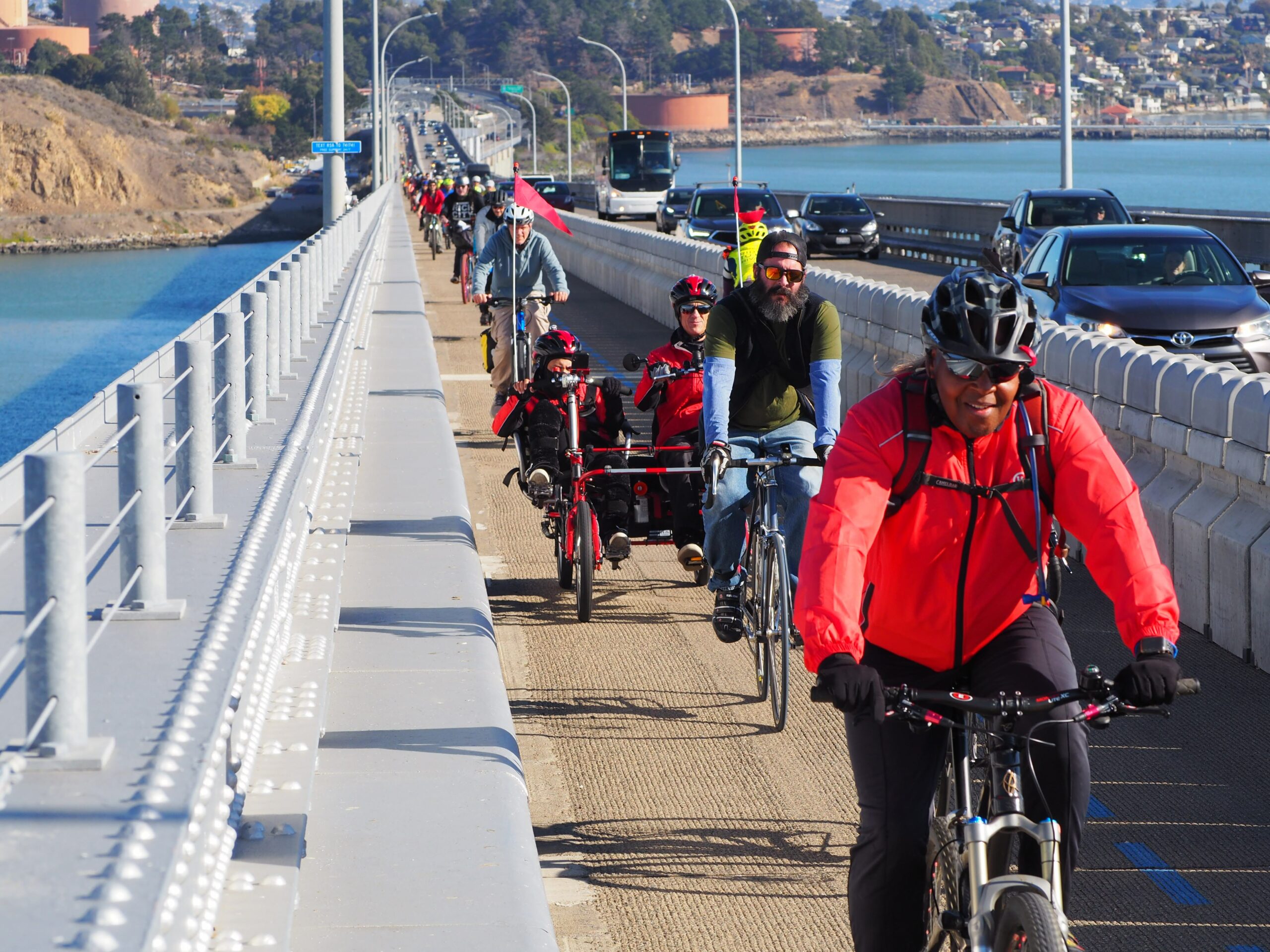
A free shuttle is provided for those impacted by the closure. Hours of operation are 6am - 8pm Mon-Wed and 6am - 2pm Thursdays.
Click here to read more and send us your shuttle feedback via our detailed blog post.
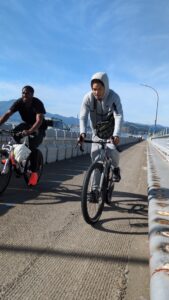
Richmond-San Rafael 6th Anniversary Ride
🚴 6 Years Strong! Riders Demand Full Access on the Richmond-San Rafael Bridge Trail A Birthday Ride with a Mission 📸 Photo by Shots From Richmond/RD López On Sunday November
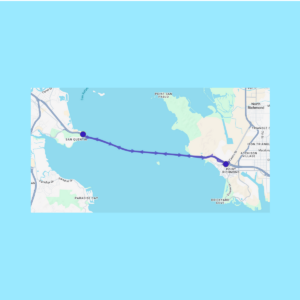
Richmond-San Rafael Bridge Trail Closures and Bike Shuttle
Learn about the Richmond-San Rafael Bridge bike shuttle ahead of the partial trail closures starting October 27, 2025.
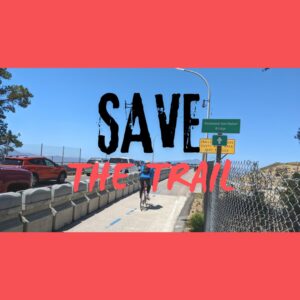
Richmond-San Rafael Bridge Trail FINAL Vote August 7; San Ramon Iron Horse Trail Bridge Now Open
Help us save one bike/walk trail bridge, and celebrate the opening of another!
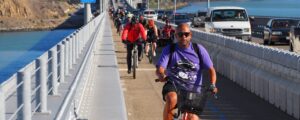
Richmond-San Rafael Bridge Trail Opponents Dodge Staff Guidance to Keep it Open
Through a public records request, we now know why the March and April votes on the Richmond-San Rafael Bridge Trail were postponed.
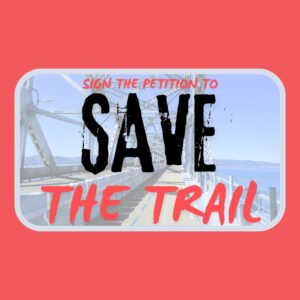
Final Vote to Save the Richmond-San Rafael Bridge Trail; Mokelumne Overpass 1st Anniversary Ride
The Richmond-San Rafael Bridge trail closure vote is coming very soon. Get involved to help save the trail!
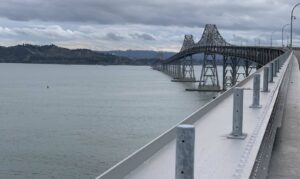
Show Your Support Now to Protect the Richmond-San Rafael Bridge Trail
Get involved to help maintain bike/walk access to the Richmond-San Rafael Bridge ahead of a major meeting coming up May 2nd, 2024.
The Richmond-San Rafael Bridge Path is closing Mondays-Thursdays. What happens now?
Article written by Warren Wells from The Marin County Bicycle Coalition, posted with their permission.
After a seven and a half hour meeting on Thursday, August 7th, 2025, the Bay Conservation and Development Commission (BCDC) agreed to close the Richmond-San Rafael Bridge multiuse path Monday through Thursday.
We are deeply disappointed by this decision, which gives up 4 miles of Bay trail to cars for half the week on a critical Bay crossing, a dangerous precedent to be set. During the meeting and in the hundreds of emailed comments, we heard from hundreds of people who regularly ride across the bridge and will be forced into traveling by car.
We feel that BCDC, an agency that is supposed to safeguard public access to the Bay shore, got this one wrong. But given that the vote went as it did, we want to explain what will be changing for those traveling between Marin and Contra Costa County.
What is changing?
The plan led by the Metropolitan Transportation Commission (MTC) and Caltrans, and rubber stamped by the Bay Conservation and Development Commission on Thursday, August 7th will do the following:
Beginning October 2025, the bridge will change from a 24/7 multiuse path (depicted in “Original Pilot” below) and return to its pre-2019 configuration every week Monday through 2 PM Thursday, meaning what is now the multiuse path will be a roadway shoulder (depicted in “Pilot Extension” below). During the days when a multiuse path is closed, a shuttle service with a bike trailer will operate over the bridge.

What does this mean for riders?
For anyone crossing the bridge on Thursday after 2 PM, Friday, Saturday, or Sunday before 11 PM, your experience will be the same. The bridge path will remain open those days, and will be accessible to people walking or biking.
For anyone trying to cross the bridge between 11 PM Sunday and 2 PM Thursday, you will have to rely on either the new shuttle service or the Golden Gate 580 bus.
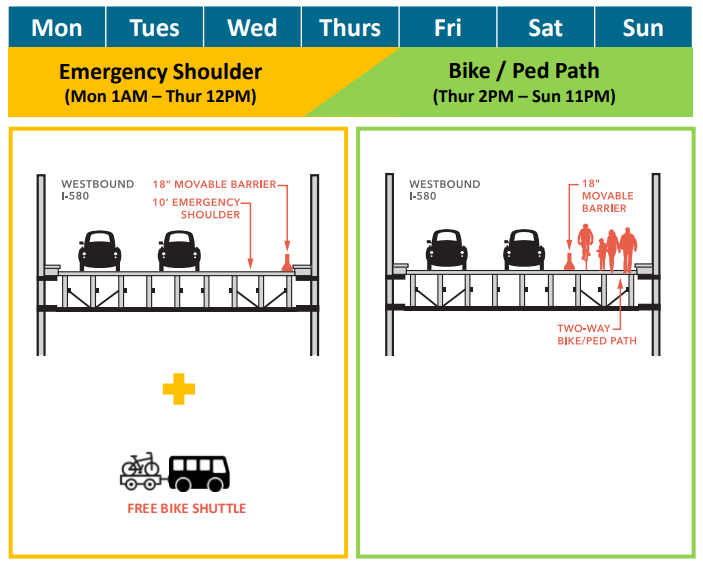
How will the shuttle work?
There are some things we know here and some things we don’t.
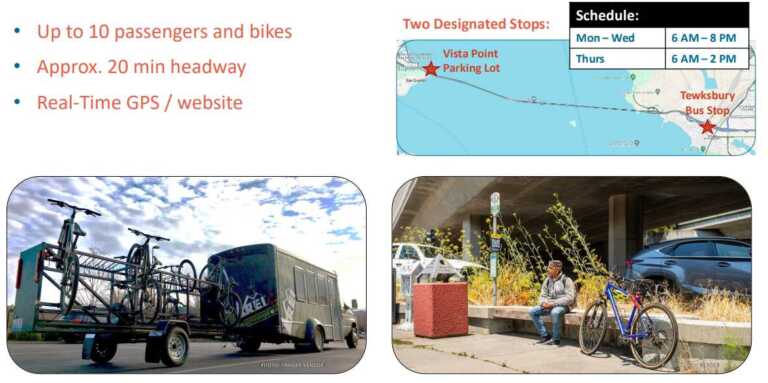
Here’s what we do know:
- The shuttle will come every ~20 minutes
- It will be free to use
- Operating hours will be 6 AM – 8 PM Monday through Wednesday and 6 AM – 2 PM Thursday (at which point the pathway will reopen)
- Pickup and drop-off will be in Point Richmond at the Tewksbury Avenue bus stop and at Point San Quentin near the scenic viewpoint
- Seating will be available for 10 passengers and their bicycles
Here is what we do not know:
- Whether the shuttle will accommodate bicycles with front racks/baskets (transit bus racks typically do not)
- Whether the shuttle will accommodate recumbent bicycles/tricycles or adaptive cycles
- Whether the shuttle will accommodate heavier e-bikes that may require the riders to lift them onto the trailer
- Whether the shuttle will accommodate bicycle trailers intended for pulling children or cargo
Anyone who has ridden the bridge will know that a large share of bikes/trikes fall into at least one of the above categories. What’s more, people riding the bikes mentioned above are less likely to be a stereotypical recreational road rider.
This means that the shuttle/trailer is least likely to accommodate:
- Older adults
- E-bike commuters
- Disabled riders
- People traveling with children
- Riders of utility or cargo bikes
These are the people we worry this decision will exclude from this 4 mile segment of the Bay Trail and critical link between the North Bay and East Bay.
Ultimately, a bike shuttle is a tool of last resort. A shuttle that formerly served the RSR Bridge corridor was cut due to low usage. Similarly, we expect to see much lower use of the shuttle than of the pathway at present.
Can people ride the bus?
The RSR Bridge is only served by a single bus route, the Golden Gate Transit Route 580 (schedule linked here). This route has similar stops to the planned shuttle, stopping in Point Richmond and Francisco Boulevard in Point San Quentin.
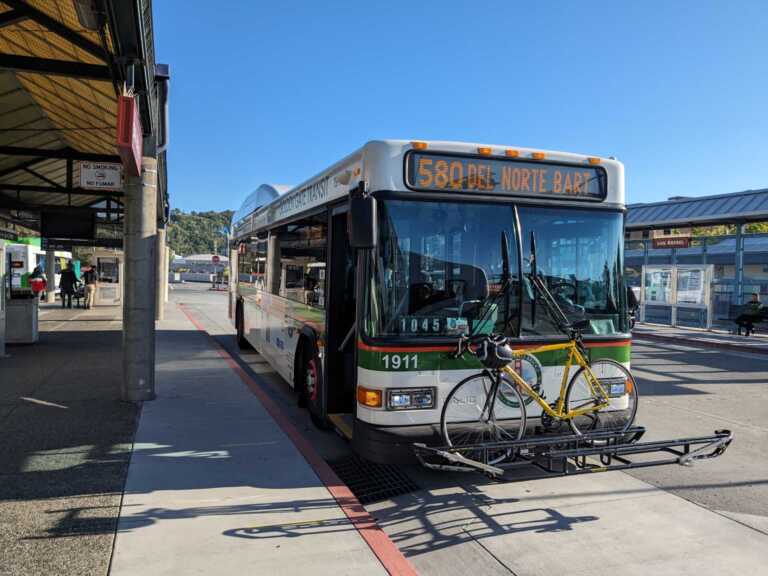
For most people aiming to cross the bridge, the 580 bus will be an inferior option to the shuttle. The bus comes only once an hour and can fit only 3 bikes, with a number of restrictions spelled out here (e.g. no baskets or front racks, no bikes over 55 lbs, no trikes or recumbents). Unlike the shuttle, the bus fare is $7.50 cash or $6 via Clipper Card/Clipper App.
However, the shuttle service will stop at 8 PM, meaning that between 8 – 10 PM, there will only be Golden Gate Transit service over the bridge. The last eastbound runs (toward Richmond) will be at 8:55 and 9:54 PM. The last westbound runs (toward San Rafael) will be at 8:48 and 9:48 PM.
What do I do if I miss the last bus?
After 11 PM Sunday and 10 PM Monday, Tuesday, and Wednesday there will be no way to cross the bridge on a bike or via public transportation until the shuttle and bus service resume at 6 AM. Those hoping to cross the bridge during that period will have to wait until 6 AM or rely on a personal connection to drive them and their bike across.
Other than that, the only option would be to use an AC Transit All Nighter route, which allows travel between the East Bay and San Francisco, and the Golden Gate Bridge, which is open to bicyclists 24/7. The closest stop to the east side of the RSR Bridge is Richmond BART (4 miles, directions here). The closest stop to the west side of the RSR Bridge is the Salesforce Transit Center in San Francisco (21 miles, directions here)
How long will this closure extend?
The plan is for this configuration to be indefinite. Between October of this year and the end of 2028, the plan is to convert the multiuse path into a shoulder/breakdown lane. After that, MTC and Caltrans’ ultimate goal is to convert what is now the multiuse path into a third westbound automotive lane, with one of the three lanes serving as an HOV lane (see the depiction below).
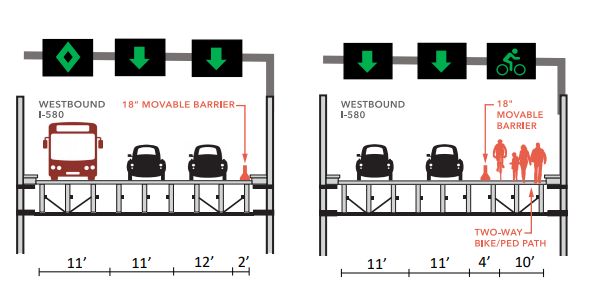
At this point MTC is maintaining that the permanent HOV lane would operate Monday-Midday Thursday with the multiuse path being open Midday Thursday-Sunday and that a daytime shuttle will continue to run during the HOV hours.
We would not be surprised to see this plan change in the next few years. As return to office increases traffic on Thursday and Friday, there will no doubt be calls to further curtail the multiuse path. And if shuttle use is as low as we expect it to be, MTC may decrease service from shuttle vehicles to a single van.
What happens after this 3 year period?
MTC and Caltrans are currently in the process of evaluating the environmental impact of adding an additional lane of traffic on the upper deck, as well as any engineering constraints involved in that.
If they determine that such a project is feasible and funding is allocated for it, the third lane would have to be approved by both the MTC and BCDC boards. This would likely take place in late 2028 or early 2029. These meetings will present another opportunity for advocacy on behalf of the multiuse path and its users.
Please sign up for our Bridging The Bay interest list below to receive additional updates. After the new configuration starts in October, we’ll have another post providing our feedback on the shuttle service.
A big thank you to everyone who signed the Bike East Bay petition, sent an email, or spoke at the meeting. Progress does not always move in a straight line, and there will be time in fight again in the future.
In the meantime… ASK THE METROPOLITAN TRANSPORTATION COMMISSION TO COMPLETE THE BAY BRIDGE BICYCLE PEDESTRIAN PATH by signing our petition below.
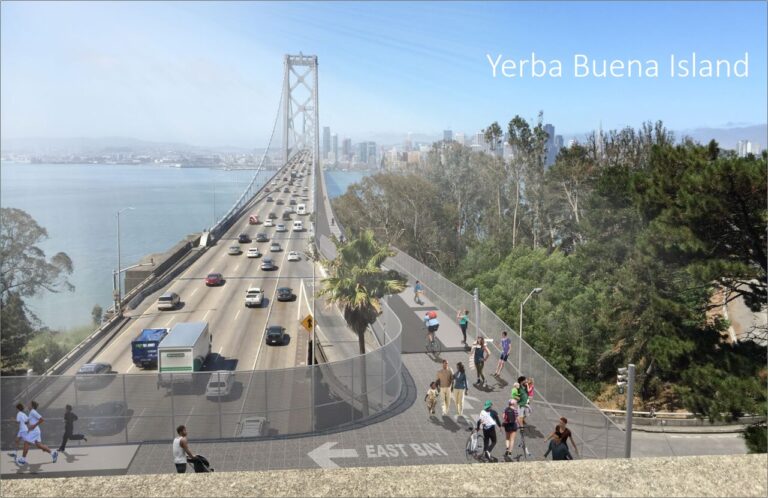
Disappointment for the Richmond-San Rafael Bridge Trail
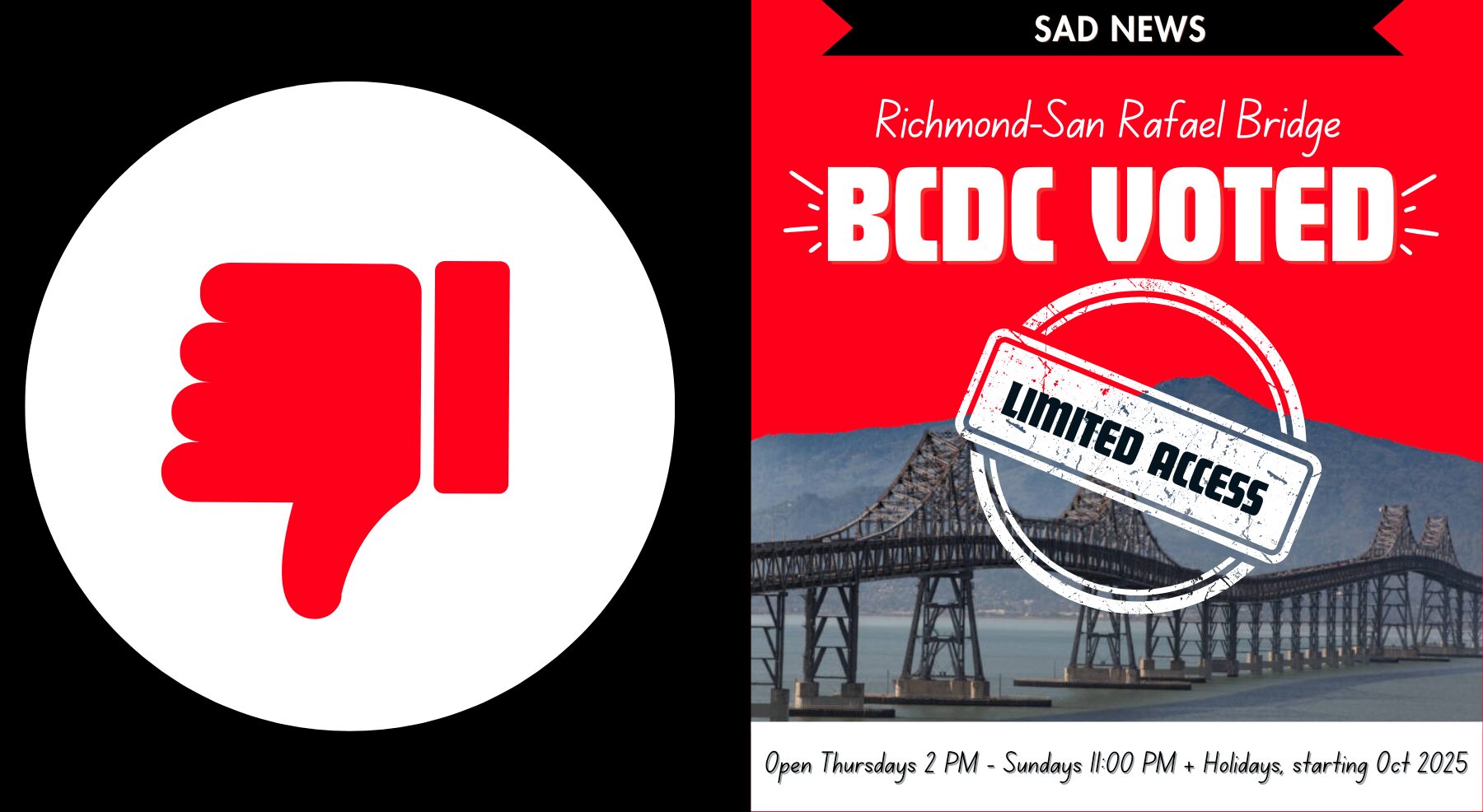
On August 7th, 2025 the Bay Conservation and Development Commission (BCDC) voted to close the Richmond-San Rafael Bridge Trail every Monday through Thursday starting in October, for conversion to a breakdown shoulder.
We were heartened by the overwhelming 80% support among the hundreds of public comments for keeping the trail open. But the commission decided to significantly restrict public access anyway, for the first time in their 60-year history.
We are in close coordination with our partners on this campaign to determine our next steps. In the meantime check out our Bluesky live posting thread from the BCDC meeting here, and sign up for our campaign list here to receive updates on this and other bike bridge projects.
WHAT YOU CAN DO NOW
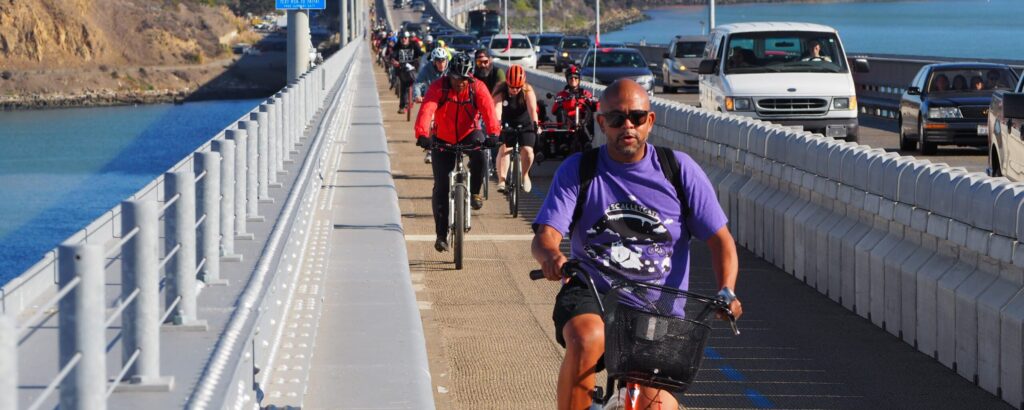
Ride the bridge as much as possible while the trail is open: whether you do it on your own, join a group ride, or encourage group rides.
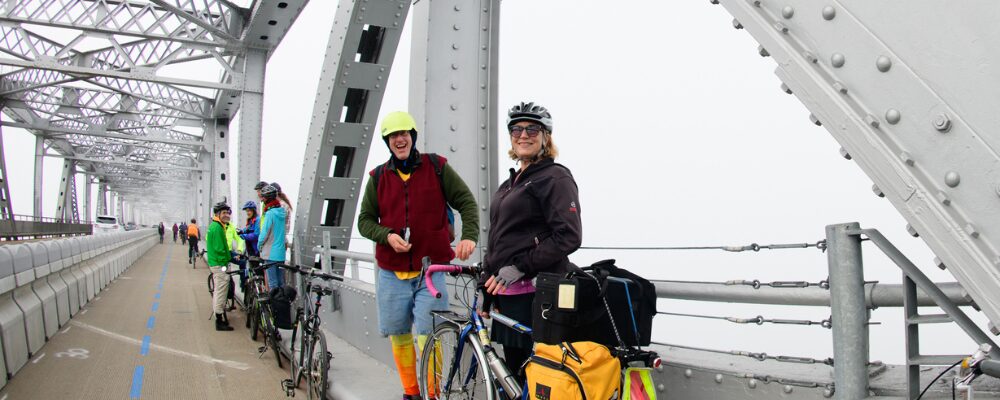
The RSR projects falls under our “Bridging the Bay” campaign. We have a dedicated email list where we share time-sensitive alerts and project updates of our efforts to enhance connectivity between East Bay communities that have long been bisected by infrastructure barriers.
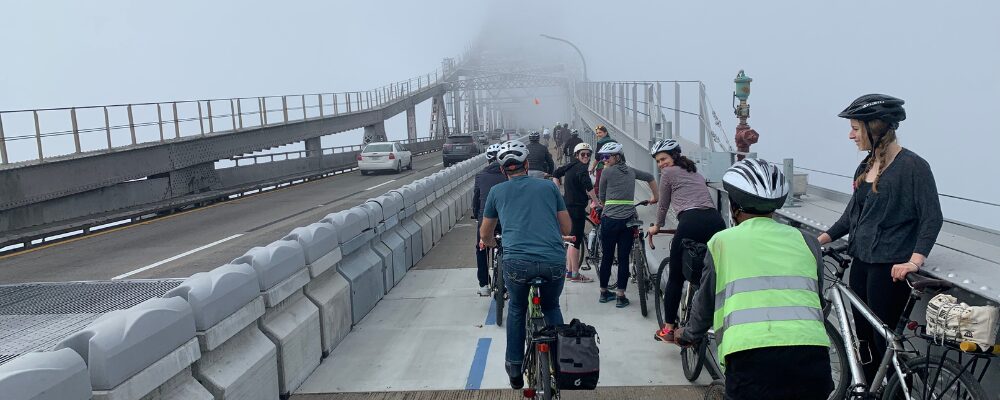
Bike East Bay fought for this path for decades, and we’re not backing down now. Donate today to ensure the Richmond-San Rafael Bridge bike path stays open seven days a week.
State law requires projects in BCDC’s jurisdiction to provide the “maximum feasible public access” consistent with the project.
The new proposal now before BCDC has not changed substantively since then.
This includes unanimous votes on resolutions to keep the trail open 24/7 from City Councils in Richmond, Albany, Berkeley, as well as via the West Contra Costa Transportation Commission and Bay Trail Board.
Over 80 transportation and sustainability organizations and community groups have signed onto Bike East Bay’s coalition letter in support of keeping the bridge trail open 24/7.
Represented in this coalition are national, state and regional organizations, as well as dozens of groups representing Richmond and other East Bay communities.
Another coalition partner is Save the Bay, one of the primary organizations that petitioned for the formation of BCDC in 1965 via the McAteer-Petris Act.
More than 5000 people have signed onto Bike East Bay’s petition in support of maintaining 24/7 biking and walking access on the Richmond-San Rafael Bridge.
This funding was already allocated in 2023 from Regional Measure 3 bridge toll revenue, per a negotiation for bicycle access improvements to the bridge trail in Richmond. This is not new funding.
It’s great that MTC is continuing to explore opportunities to further enhance bike/walk access to the bridge trail, especially since some of the connectivity investments on the Marin side weren’t made until partway through or fully after the 3-year bridge trail pilot period.
However, these and all of the other investments that have been made in bridge trail connectivity will lose value if bike/walk access on the bridge is reduced.
Increased access to the bridge trail and Marin County from Richmond on Fridays through Sundays does nothing to help people who need to cross when the trail is closed Mondays through Thursdays.
Such an impact would not be considered acceptable for car commuters, and it is just as unacceptable for bike/walk traffic.
As part of a study for an HOV lane on the bridge, MTC insists that they need to test the zipper barrier separating the trail from the roadway by moving it twice per week.
This test is being performed to understand how the bridge deck holds up to more frequent movement of the heavy concrete barrier.
However, these barrier movements could be performed all at once overnight every week, instead of every Monday and Thursday with the trail fully closed in between.
The barrier is already moved back and forth once per month overnight to allow Caltrans to perform maintenance on the bridge, with a free shuttle provided throughout the impact period.
This same strategy could be employed weekly with very minimal impact to trail users.
The schedule as described in MTC’s proposal means there will be neither bridge trail nor shuttle access for 37 hours of every week.
This will also mean 31 hours every week when there is no trail, shuttle, or even bus access. During these hours the only way to cross the bridge will be by car.
The proposed shuttle does not appear to accommodate non-standard bike frames (recumbents, adult trikes, handcycles, etc), meaning further impacts on people with disabilities who will have no bridge crossing option.
Caltrans’ own Bay Area Bike Plan update that was just finalized this past month lists permanent, all-hours biking and walking access on the Richmond-San Rafael Bridge as one of the top ten projects for Marin County, and this is included as a Tier 1 priority project.
The permit amendment proposal Caltrans is participating in to reduce bike/walk access on the bridge is in conflict with their own, newly adopted plan.
Existing, funded projects via MTC’s Richmond-San Rafael Bridge Forward initiative to address the primary westbound congestion pinch points should be completed and studied before any further changes to the bridge are considered.
These include the open road tolling project, the westbound HOV/bus lane approaching the toll plaza, and the Richmond Parkway interchange project.
Additionally, funding for increases in transbay bus and other transit service need to be prioritized, not just transit lanes, enabling more crossings without adding more driving miles.
The Metropolitan Transportation Commission (MTC) wants to close the Richmond-San Rafael (RSR) bike/walk pathway every Monday through Thursday, converting it into a non-drivable breakdown lane. They refuse to acknowledge that it WILL eliminate critical access for people who do not drive and rely on the RSR Bridge as the primary connection between the East & North Bay.
It is short-sighted for decision-makers to exclusively prioritize cars over other modes of transportation, especially in the face of a climate crisis. We need MORE access, not less.
Under MTC’s proposal, the existing movable zipper barrier would be moved back and forth on the weekends to allow bikes and pedestrians, but even this concession does not consider equitable access needed for those who must cross during the week.
MTC cannot make the decision without approval from the San Francisco Bay Conservation and Development Commission (BCDC). We will continue to organize ahead of their meeting: sign the petition to tell BCDC to maintain bike/walk access on the RSR Trail 7 days a week, 24 hours a day.
Over 5,200 people have signed our petition, and 80+ organizations have signed a coalition letter in support keeping the Richmond-San Rafael Bridge accessible.




Frequently Asked Questions
Thanks to our friends at the Marin County Bicycle Coalition for curating this information. Visit their website for all the great work they are doing in the North Bay!
No! In the Fall of 2019, after decades of advocacy from activists on both sides of the Bay, the people path on the Richmond-San Rafael Bridge opened to great fanfare, as part of a four-year pilot project. Since then, over 400,000 people have crossed by bike or on foot.
The Bay Area Council, a regional business group with roles in the creation of BART and the Bay Conservation and Development Commission, is the primary advocate for a third westbound car lane on the bridge. Via a front group called the “Common Sense Transportation Coalition” they sent mailers to residents of Richmond, paid for ads on Facebook and YouTube, and a full page ad in the SF Chronicle.
Their website makes inaccurate statements about the pathway, including a misleading claim that “The third lane of the westbound deck of the Richmond-San Rafael Bridge was closed to cars to provide for a pedestrian and bike lane along the bridge.” Before it became home to the bike path, the “third lane” on the upper deck had been a shoulder/breakdown area since the 1970s and not a travel lane.
Morning traffic headed from Richmond to Marin is bad, there’s no disagreement about that. The question is, “Would a third lane fix it?”. The answer is complicated.
Moving the pathway barrier to the side to make a third lane on the bridge won’t solve anything, because there are only two “receiving lanes” on I-580 near San Quentin, meaning the traffic jam would just move from the approach to the bridge to the bridge itself. A 2021 study from the Transportation Authority of Marin (TAM) found that I-580 would have to be widened to see congestion reduction benefits, costing $70-90 Million. But while this would shorten trips for travelers headed north on US-101, these changes would increase commute times for those headed south. To reduce congestion in both directions, an additional $250 Million dollars would be needed for a new freeway ramp.
But that would still not solve traffic problems, as decades of failed promises from freeway widenings across California and the US have proven. When we widen roads for cars, the congestion relief persists for only a short period before returning. This is because people change their behavior in response to changed conditions.
Commuters who once drove to work early to beat traffic start coming to the office later. Folks who might have passed up a job in Marin due to the long commute time decide to take it instead. Others move further away into sprawl developments enabled by the initially faster drive times. This phenomenon is called “induced travel” and it’s why the five-year, billion-dollar project to widen I-405 in Los Angeles saw traffic return worse than before within just a few years after completion.
Lastly, it is also unknown if adding more cars to the upper bridge deck, and another four-mile concrete barrier for a pathway on the lower deck, is feasible from a structural standpoint. With larger trucks and SUVs more prevalent on our roadways, and EV batteries adding additional weight, a 6-lane bridge would be under more stress than ever before. None of the recent reports evaluated the degree of strengthening to the bridge that a third lane would require, but we understand that Caltrans is studying it now.
Several local news reports have repeated a concern that the pathway was causing pollution in Richmond. The Bay Area Council stated that “Traffic congestion caused by backup on the Richmond-San Rafael bridge is now the number one source of non-wildfire air pollution in the City of Richmond,” implying that adding a third westbound lane would change that.
When we asked them for their source they pointed us to this December 2022 report from PSE Healthy Energy. We reached out to the report’s authors to ask if the claim was supported by their study, and they responded that no, the study did not come to this conclusion.
In fact, the Richmond Chevron refinery is responsible for 63% of the pollution, and all road traffic in the area (not just the bridge) makes up 7%.
Air quality is indeed a huge and longstanding issue in Richmond due to the presence of the Chevron refinery and multiple freeways. Residents of Richmond suffer higher rates of asthma, heart disease, and low birth weight than state averages due to poor air quality.
The 2022 PSE study acknowledged these harms but didn’t indicate that the solution to harmful emissions from a freeway is “more cars,” which a third lane would inevitably lead to. The report authors lay out several air quality mitigation measures including electrifying truck fleets, increasing transit service, and planting trees. Notably absent from their list of mitigations is adding a third lane on the bridge.
In the summer of 2022, Caltrans published an interim report on the pathway pilot (link here – warning large PDF). After the installation of the pathway, vehicle flow on the bridge decreased slightly during the peak period. Likely due to the shorter merge following the toll plaza, about 2.5 cars/minute, fewer can use the bridge.
Additionally, maximum speeds on the bridge are slightly lower than before, possibly due to the visual effect of a narrower driving space. As an unintended benefit of this, severe injury collisions are down significantly on the upper deck at a time when such severe collisions increased on the three-lane lower deck.
On the question of delay, Caltrans found that “Travel times to access the bridge from I-80 remain close to historical averages on weekdays, Saturdays, and Sundays,” and that reduced speeds on the bridge have only increased travel times “by less than one minute” compared to before the path’s installation.
This report used data through July 2022. A final report will be released in the summer of 2024 and will update these findings.
While Richmond has done a truly remarkable job since 2019 of providing protected bikeway approaches from BART, the Richmond Greenway, and the Bay Trail, Marin has not done its part. Users are left deciding between a dangerous ride on East Sir Francis Drake past San Quentin or vying with heavy truck traffic on Andersen Drive.
These gaps in infrastructure limit the use of the bridge path. We know that most people will only choose to ride bicycles for transportation if they feel safe from motor vehicle traffic. The current conditions work only for the most brave and enthusiastic riders but fail everyone else.
Happily, there are projects in the works. A half-mile bike/walk path gap on Francisco Boulevard East was finally completed in mid-2025, five years after the bridge path opening. And a proposal to extend the Bay Trail past San Quentin to the intersection of East Sir Francis Drake and Andersen Drive is in the early planning stages.
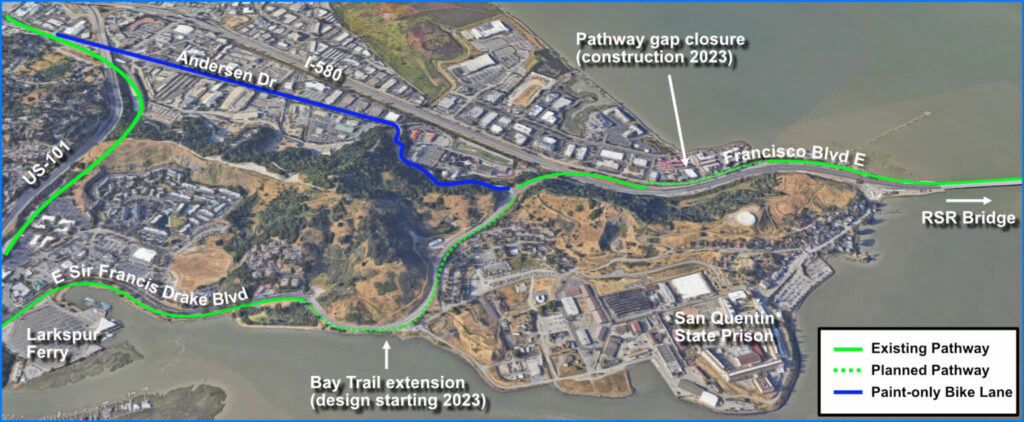
Advocates for another lane on the bridge propose spending a huge amount of money on it, up to a third of a Billion dollars! What could be done with that money instead of another lane that will inevitably fill up? This could warrant its own blog post, but some ideas are:
- More frequent transit – This could include a new Richmond-North Bay ferry, and bus service on the bridge with the third lane possibly used as transit-only during peak hours
- E-bike subsidies – Continuing and expanding on the $500-1000 rebates previously offered to Richmond-San Rafael Bridge commuters
- Peak-hour tolling/congestion pricing, to smooth out demand
- Workforce housing development in the North Bay – Increasing affordability and reducing the need for more transbay commute trips altogether
Fundamentally, the commute problem is a land use problem. A generation ago, just over half of Marin’s workforce lived outside of the county. Today that share is two-thirds. Many service sector, healthcare, and school employees cannot afford to live in Marin, and instead must endure hours-long trips to work.
If we truly care about the people forced to make increasingly more difficult commutes to their jobs in Marin, the best solution is offer them an affordable home closer to work.
Equity & Access
Mobility justice is a vision that centers our right to exist and move freely, safely and joyfully throughout our communities. It acknowledges that people’s identities and lived experiences shape how we move through streets, and seeks to address systemic inequities.
As bicycle advocates, we must recognize and account for the ways that closing down the Richmond-San Rafael Bridge path will disproportionately affect people who ride their bicycles out of transportation necessity, not just recreation. For many, lack of access to a personal car and limited public transit options across the bridge present real challenges.
We encourage MTC and other decision-makers to think long-term about how we can create infrastructure that centers people first, not cars.
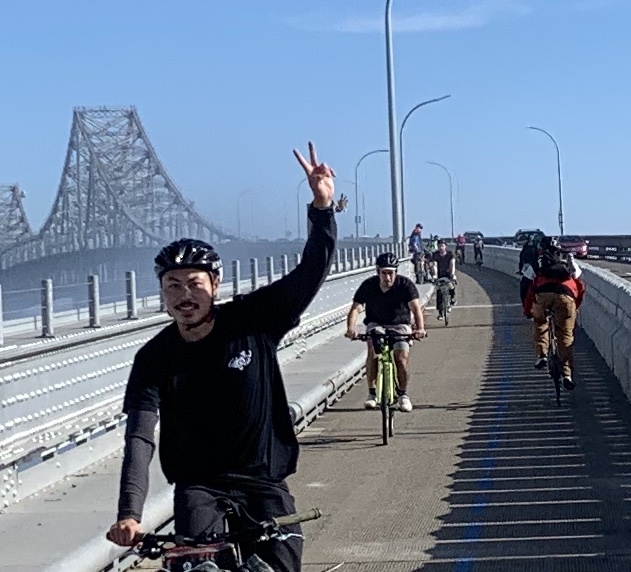
More Information
We joined Marin County Bicycle Coalition in June 2024 to answer your questions and share ways to get involved with the campaign. Check out the recording to catch up to speed.
Important Updates - Timeline
Disappointing – the Bay Conservation and Development Commission (BCDC) voted to restrict biking and walking access on the Richmond-San Rafael Bridge to Thursdays 2PM – Sundays 11PM and Holidays, providing a free shuttle to transport people and bicycles 6am-8pm when the trail is closed. The new schedule and operations taking effect October 2025 is set to last 3 years.
The Bay Conservation Development Commission (BCDC) staff recommendation for the scheduled Aug 7th discussion and final vote meeting is available here TAKE ACTION NOW AND JOIN US IN PUSHING BACK!
Click here for the complete meeting details, and how to submit your public comment by email, Zoom, or in person.
The Bay Conservation Development Commission (BCDC) meeting info for Thursday, August 7th has now been published here, with the bridge trail closure proposal as agenda item 9.
The final vote on bridge access is now scheduled as part of the August 7, 2025, Bay Conservation and Development Commission meeting.
Read more details on our blog post here, and access the meeting agenda here.
The chair of the Bay Conservation Development Commission (BCDC) stated during their June 5th meeting that they’re “hoping to discuss and vote on the RSR Bridge on August 7th meeting starting at 10AM”.
We are awaiting confirmation that this will be the case to share it broadly. MTC and Caltrans are still trying to bring a trail closure proposal back to BCDC.
Bay Conservation Development Commission (BCDC) staff were going to recommend keeping the Richmond-San Rafael Bridge Trail open 24/7, while indicating that the Metropolitan Transportation Commission (MTC) and Caltrans closure proposal did not meet the “maximum feasible public access” standard. <p>
MTC and Caltrans are still trying to bring a trail closure proposal back to BCDC sometime in Summer 2025. This will happen in August at the earliest, possibly at the BCDC meeting date on the 7th or the 21st.
The April 3rd hearing and vote on the Richmond-San Rafael Bridge trail has been postponed again, this time indefinitely.
Here is the info from the Bay Conservation Development Commission (BCDC) meeting agenda:
“Caltrans has requested BCDC postpone the Commission’s scheduled public hearing and vote on Caltrans’ Richmond-San Rafael Bridge permit application, which was set for Thursday, April 3, 2025. Caltrans plans to amend its permit application, and BCDC looks forward to considering an amended project that we expect will provide additional potential transportation benefits and maximum feasible public as consistent with that project. See Attachment B for more information.”
This delay is good news, and likely a result of all the folks who wrote in and expressed their concerns about the trail closure proposal. Thank you!
However we aren’t letting our guard down, and will continue sharing any updates we receive with everyone who has signed our petition. If Caltrans and the Metropolitan Transportation Commission are going to continue pursuing a trail closure we should know within the next three months.
So for the time being, good job everyone and go enjoy a bike ride or walk on the bridge!
FURTHER UPDATE as of March 27th: The April 3rd BCDC hearing and vote on the bridge trail has been postponed again. See the note at the top of this page for details.
ATTENTION: The Bay Conservation and Development Commission meeting and final vote was originally scheduled for March 20th, but has since been rescheduled to Thursday, April 3rd, with less than a week’s notice.
We sincerely apologize for the inconvenience, as we know many people took time off in order to participate on the originally scheduled date. We hope that you can still join us for the new meeting date, and appreciate your support by making a public comment in whatever format is available to you.
The April 3rd meeting details will be published here within a week of that event date.
The Bay Conservation and Development Commission (BCDC) will hold a hearing and final vote on Thursday, March 20th starting at 10AM to decide on the future of the bridge trail. Sign our petition below, and read our latest blog post here for more info and ways to get involved.
The Bay Conservation Development commission held a non-voting workshop on the Richmond San-Rafael Bridge pilot at their 1/16/25 meeting. Decision day is now expected to be in March 2025.
Berkeley City Council votes unanimously on a city resolution in support of keeping the Richmond-San Rafael bike/walk path open 24/7.
January BCDC meetings on the 2nd & 16th – 28 days notice for the 2nd has already passed, 28 days before the 16th will be Dec 19 – awaiting confirmation.
Hundreds gather to celebrate the 5th anniversary since the opening of the trail on Nov 16, 2019. Read coverage from The Grandview Independent and from Richmondside
Caltrans notices have been posted at the bridge path, so we expect a vote at BCDC sometime between Nov 2024 and Jan 2025.
The West Contra Costa Transportation Commission (WCCTC) unanimously votes to sign a resolution to recommended continuation of the Richmond-San Rafael bridge trail pilot until after the completion of the westbound I-580 open road tolling and HOV lane project.
This is the fourth council/board resolution in support of the bridge trail so far (WCCTC, Albany, Richmond, Bay Trail), each passed with a unanimous vote. View the text of the resolutions here.
The City of Albany unanimously supports a resolution in support of keeping the path. “NOW, THEREFORE, BE IT RESOLVED that the City Council of the City of Albany does hereby support 24 hours a day, 7 days a week access to the Richmond-San Rafael Bridge Trail for pedestrians and bicyclists.”
Frustrating news: MTC requested and received initial authorization from BATA (Bay Area Toll Authority) to advance their plans for eliminating access of the RSR Trail. While this isn’t a final approval, it’s a significant step backwards. Help us keep the momentum by signing the petition!
A resolution of the council of the City of Richmond, California, affirming Richmond’s support for the Richmond-San Rafael bridge trail is signed with unanimous support.
Bay Trail Board of Directors signs resolution: “NOW, THEREFORE, BE RESOLVED that the San Francisco Bay Trail Project Board of Directors opposes closure of the multi-use Richmond-San Rafael Bridge Trail and authorizes each member of the Board to employ this resolution in advocating for keeping the RSR Bridge Trail open.”

Further Reading
July 20, 2025: Richmond-San Rafael Bridge trail faces final closure vote at August 7 meeting (Grandview Independent)
March 28, 2025: Cyclists cheer as Richmond-San Rafael bridge bike lane vote is delayed again(Richmondside)
March 28, 2025: Caltrans withdraws plan to convert Richmond Bridge Trail into breakdown lane (Grandview Independent)
March 26, 2025: Opinion: Keep the Richmond-San Rafael Bridge Trail open (East Bay Times)
March 5, 2025: Advocates Fight Potential Loss of Bike/Ped Access to Richmond-San Rafael Bridge (CalBike)
January 15, 2025: Reducing Richmond bridge bike lane access is Thursday meeting topic (Richmondside)
December 13, 2024: The Ongoing Saga of the Richmond-San Rafael Bridge Bike Lane (KQED)
December 12, 2024: Should cyclists continue to have full access to the Richmond-San Rafael Bridge? (Richmond Confidential)
November 19, 2024: Mass of bicyclists enjoy Richmond bridge ride but lane access remains at risk (Richmondside)
November 16, 2024: Advocates celebrate fifth anniversary of Richmond-San Rafael Bridge path, warn of potential closures (Grandview Independent)
November 16, 2024: Bay Area cyclist show support to keep Richmond–San Rafael Bridge open to bikes 24/7 (CBS Bay Area)
June 26, 2024: Cyclists commuting across bridge to Marin may need to find alternative four days a week (Richmondside)
June 6, 2024: Richmond-San Rafael Bridge – Is the Pathway Coming to an End? (Marin County Bicycle Coalition )
May 23, 2024: Call to Action: Next Step to Save the Richmond-San Rafael Bridge Bike Lane (Streetsblog)
May 16, 2024: Richmond cyclists celebrate 30 years of Bike to Work Day (Grandview Independent)
April 26, 2024: Who Rides on the Richmond-San Rafael Bridge, Anyway? (Marin County Bicycle Coalition)
March 18, 2024: Richmond-San Rafael Bridge pedestrian lane may soon be removed after four-year pilot (East Bay Times)
January 9, 2024 Richmond Bridge Bike Path Has an Amazing View — and an Uncertain Future (KQED)

